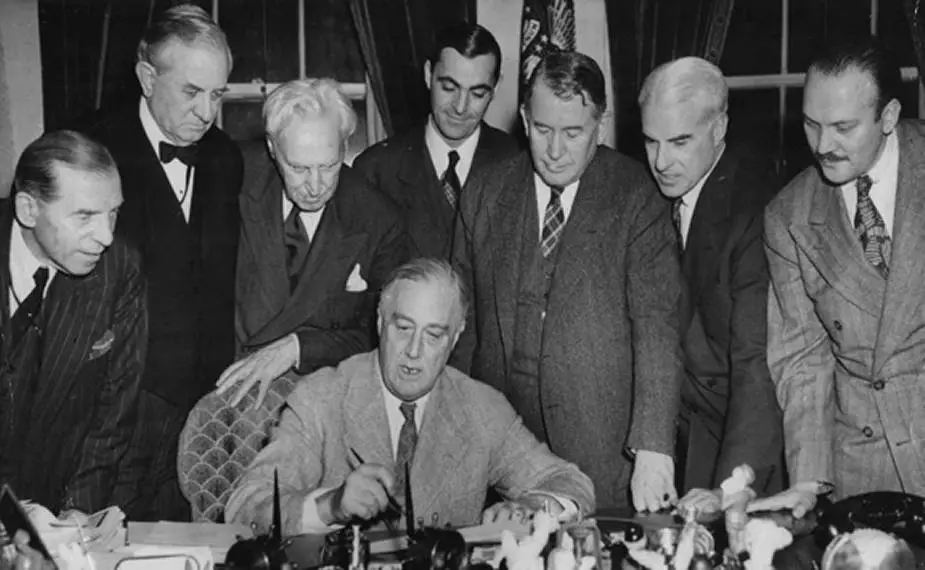Breaking news
US President Biden signs Lend-Lease Act to supply more security assistance to Ukraine.
On May 9, 2022, U.S. President Joe Biden signed into law the "Ukraine Democracy Defense Lend-Lease Act of 2022", David Vergun, U.S. Department of Defense, reports. The act authorizes the administration, through the fiscal year 2023, to lend or lease military equipment to Ukraine and other Eastern European countries. The act would exempt the administration from certain provisions of law that govern the loan or lease of military equipment to foreign countries, such as the five-year limit on the duration of the loan or the requirement that receiving countries pay all costs incurred by the United States in leasing the defense equipment.
Follow Army Recognition on Google News at this link

On May 9, 2022, U.S. President Joe Biden signed into law the "Ukraine Democracy Defense Lend-Lease Act of 2022" (Picture source: Reddit)
Any loan or lease of military equipment to Ukraine would still be subject to all applicable laws concerning the return of such equipment. Under current law, payments received under leasing agreements with foreign countries are deposited in the Treasury Department as miscellaneous receipts and are classified as direct spending. This act could increase amounts deposited in the treasury if the administration lends or leases equipment that it otherwise would not have provided under current law.
Conversely, those deposits would decrease if the administration lends or leases equipment at a reduced cost under the act relative to amounts it otherwise would have charged under its existing authorities.

President Franklin D. Roosevelt signs the Lend-Lease bill (March 1941) (Picture source: U.S. National Archives)
Lend-Lease Act, a formidable tool for military assistance
Lend-lease has been used during World War II. At that time, a total of $50.1 billion, equivalent to $690 billion in 2020, worth of supplies were shipped. In all, $31.4 billion went to the United Kingdom, $3.2 billion to France, $1.6 billion to China, $11.3 billion to the Soviet Union and the remaining $2.6 billion to other allies.
Lend-Lease, formally introduced as An Act to Promote the Defense of the United States (Pub.L. 77–11, H.R. 1776, 55 Stat. 31, enacted March 11, 1941), was a policy under which the United States supplied Great Britain, the Soviet Union and other Allied nations with food, oil, and a very wide range of military materiel between 1941 and 1945. It was given on the basis that such help was essential for the defense of the United States; this aid included warships and warplanes, along with other weaponry. It was signed into law on March 11, 1941, and ended on September 20, 1945. In general, the aid was free, although some hardware (such as ships) was returned after the war. Canada operated a similar smaller program called Mutual Aid.
A total of $50.1 billion (equivalent to $690 billion in 2020) worth of supplies was shipped, or 17% of the total war expenditures of the U.S. In all, $31.4 billion went to the United Kingdom, $11.3 billion to the Soviet Union, $3.2 billion to France, $1.6 billion to China, and the remaining $2.6 billion to the other Allies. Reverse Lend-Lease policies comprised services such as rent on air bases that went to the U.S., and totaled $7.8 billion; of this, $6.8 billion came from the British and the Commonwealth. The terms of the agreement provided that the materiel was to be used until returned or destroyed. In practice, very little equipment was returned and most was destroyed during the war. Supplies that arrived after the termination date were sold to the United Kingdom at a large discount for £1.075 billion, using long-term loans from the United States. Canada's Mutual Aid program sent a loan of $1 billion and $3.4 billion in supplies and services to the United Kingdom and other Allies.
Lend-Lease effectively ended the United States' pretense of neutrality which had been enshrined in the Neutrality Acts of the 1930s. It was a decisive step away from non-interventionist policy and toward open support for the Allies. Roosevelt's top foreign policy advisor Harry Hopkins had effective control over Lend-Lease, making sure it was in alignment with Roosevelt's foreign policy goals.

U.S. stamp of World War 2 advertising the Lend-Lease Act

Poster issued in World War 2 to advertise the Lend-Lease Act



















